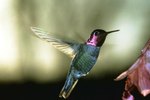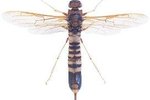
When a male nest building bird sets out to attract a mate, he doesn't kid around. He may spend weeks on his creation. His architectural feats captivate photographers and birdwatchers worldwide. In species where males build or begin nests, mature male birds with the strongest skills have a competitive advantage. They're more likely to attract females and succeed at passing on their genes. Male nest building demonstrates skills and fitness to potential mates.
Bowerbird Bachelor Pad
The male bowerbird builds and decorates a tent-like structure on the ground to lure females to mate. Although his twig gathering and building activities aren't aimed at creating the nest that holds eggs and later nestlings, his efforts get bowerbird mating off to a start. Bowerbird creations include colorful materials and elaborate design elements. One species favors blue, others use multiple colors to attract female favor. It's the female bowerbird who builds the nest where she'll lay her eggs, near the structure of the male who captivated her with his decor.
Weavers Improve With Practice
Village weavers and other weavers who construct well-shaped nests woven from twigs get better at their nest-building over time. Young males produce nests that aren't as well formed as those made by mature males, although even birds raised in isolation create nests of the kind their species make. Weaver nest building seems to come about through instinct and learning. In several weaver species the male begins a nest that becomes a platform for his mating display. Male wrens also use this tactic.
Nestbuilding Courtship
In most titmouse species, commonly called tits, the female builds the nest. In penduline tits, the male begins the nest. He creates a bulbous hanging nest at the end of a twig in a safe place, usually above water. It's masterfully shaped with long fibers, making it ready for a female to complete, Berndt Heinrich reports in his book, "The Nesting Season." In South America the ovenbird takes months to create a mud or clay orifice-shaped receptacle for nesting. The male and female construct the nest using hair, fibers and straw. Just as adobe hardens in the sun, the ovenbird nest becomes rock-solid as it bakes. It provides a protective shelter for the eggs and young.
Courtship Displays
Certain male birds create elaborate displays to attract females. The loggerhead shrike spikes his kills on barbed wire or thorns to show off his hunting skills to potential mates. Loggerhead shrikes prey largely on lizards, and when they attack horned lizards, they wisely choose the ones with the shortest horns, "The New York Times" reports. The elaborate bowers of the male bowerbirds may have started out as nests and evolved into a courtship display, Heinrich suggests. Demonstrating abilities as a provider or builder tells females he's worth checking out. Unlike an actual nest for eggs, which generally needs to be unobtrusive, these male displays use flamboyance to increase his chances of mating.
References
Resources
Photo Credits
-
Stockbyte/Stockbyte/Getty Images
Writer Bio
Gryphon Adams began publishing in 1985. He contributed to the "San Francisco Chronicle" and "Dark Voices." Adams writes about a variety of topics, including teaching, floral design, landscaping and home furnishings. Adams is a certified health educator and a massage practitioner. He received his Master of Fine Arts at San Francisco State University.




